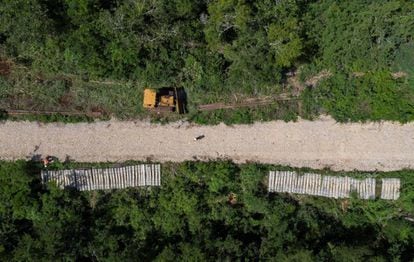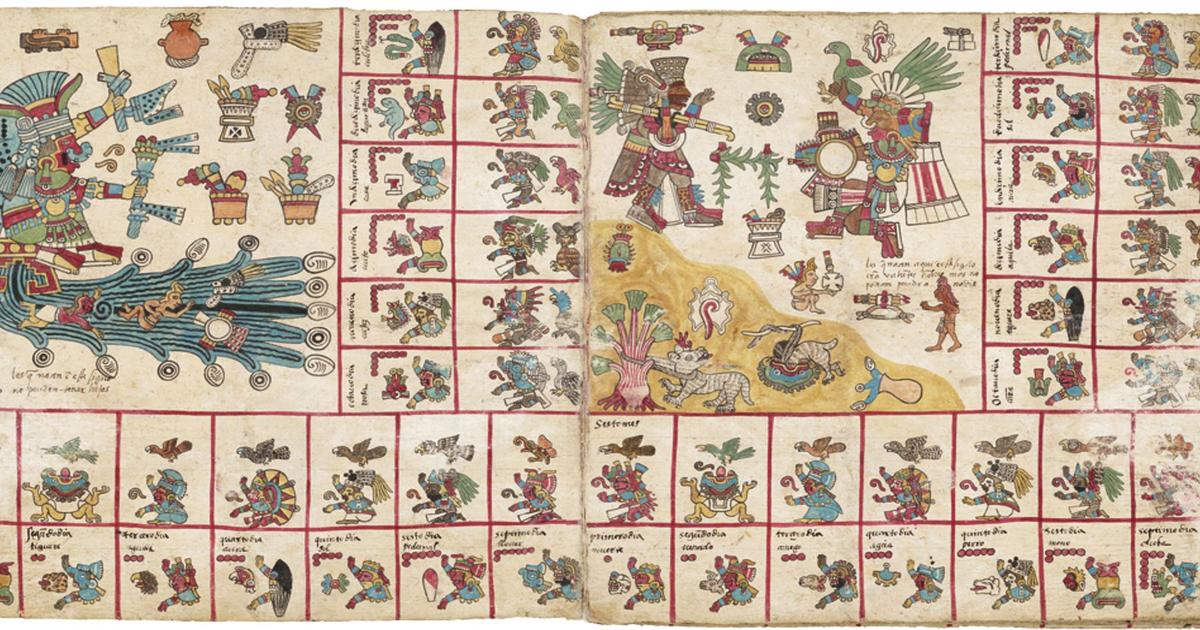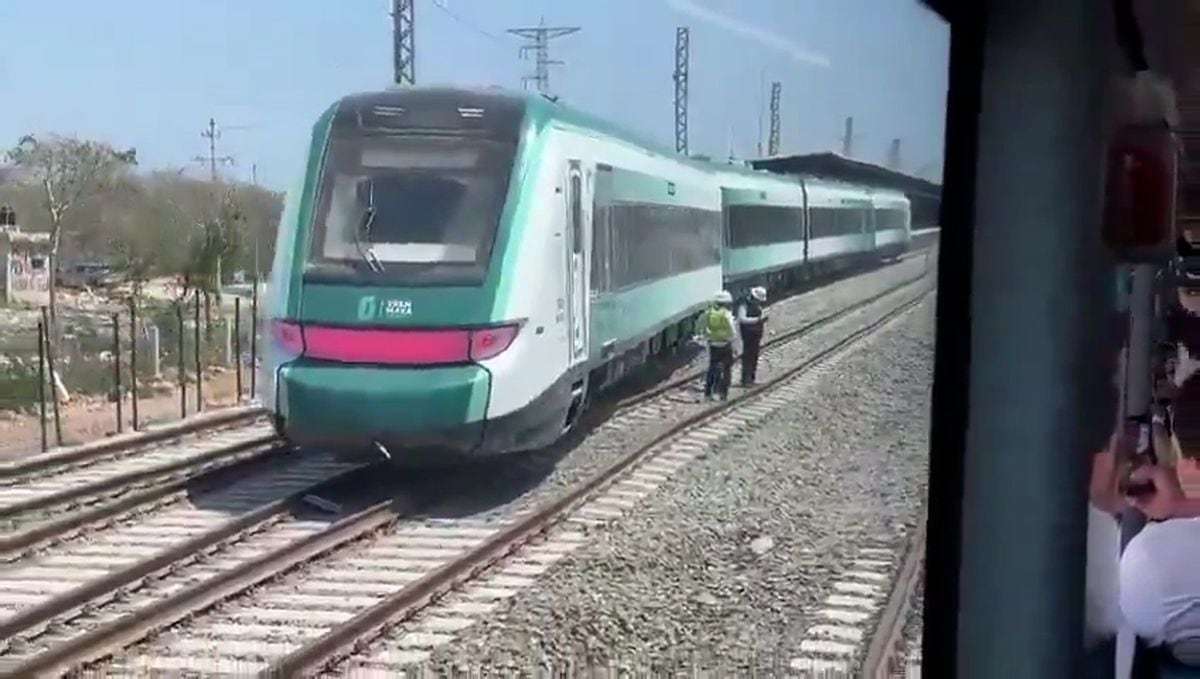The Temple of the Jaguar, in Palenque, Chiapas.Education Images / Getty Images
In a mine of archaeological treasures yet to be explored such as the Yucatan Peninsula, any groove in the earth can uncover a fragment from hundreds of years ago. With the construction of the 1,500 kilometer infrastructure for the tourist megaproject of the Mayan Train, the findings have not taken long to emerge from the ground. The National Institute of Anthropology and History of Mexico (INAH) has collected 13,911 archaeological pieces so far, but their nature, value and size - hidden under the Institute's secrecy - have yet to be known. Meanwhile, the construction of the project progresses without alterations to the route and stumbling in its first sections due to the deposits that it is discovering in its path, still with the heated controversy over a project rejected by local communities due to its impact.Faced with the secrecy of the authorities, the Mayan community repeats its own history and fears that its cultural heritage will once again be the victim of looting, pillaging or destruction in the name of progress.
The train, which takes the name of the civilization that inhabits the lands through which it runs, is a promise of development for the states in the southeast of the country.
In addition to tourism, commerce, infrastructure and economic activity, the project ensures the protection and enhancement of the archaeological heritage that it finds in its path.
To do this, a team of more than 80 archaeological operatives work together with the INAH to carry out the tasks of salvaging the "unidentified material heritage" in the construction area.
With the help of topographic mapping with laser technology and excavations, thousands of pieces have been unearthed, but the Institute has not specified, at the request of this newspaper, if they are vessels, beads or ceremonial objects of greater value.
More information
The tourist gems on the Mayan Train route
Until now, the authorities have reported on the archaeological remains found in the first four sections of the construction of the train route. In the jungle route from Palenque to Escárcega, 2,429 have been found; in the one that goes to Calkini, another 2,211; from there to Izamal, the works have brought to light 6,269 pieces; and in the section that connects to Cancun, another 3,002. The National Fund for the Promotion of Tourism (Fonatur) has reported that these are movable and immovable property that will form part of the "historical, scientific and cultural heritage of the country" and that they will go through the protection protocols. If they consider it, the work will stop and the archaeologists will be channeled to attend to the findings.
However, recent discoveries within the right-of-way in Campeche have staggered the project. These are real estate such as roads, platforms, housing areas and structures, but also ceramic, lithic and bone remains near the passage of the roads. "In the specific case of the area in Campeche, it is indeed a site that has monumental architecture, which will be registered, protected and, in the medium term, the feasibility of its opening will be seen," the INAH reported. who remembers that opening an archaeological zone implies "a lengthy process that has to do with the exploration, conservation and enhancement of the site to offer the conditions implied by receiving public visits." Even so, no modification has been reported in the initial route of the train.
Workers work in the construction of the Mayan Train, in the municipality of Maxcanú, in Yucatán.
The doctor in Archeology and researcher at the Institute of Anthropological Research, Rodrigo Liendo, explains that due to the high number of finds, the archaeological pieces in question may be mere fragments of lesser value. “That count could be due to small objects like a bead or a piece of a broken pot, or just pieces of pottery. I don't think it's much more than that. " However, one of the researcher's concerns is that the excavation works - which cover half a kilometer on each side of the road and advance at cruising speed to inaugurate the first section in 2023 - require heavy machinery that could damage the buried remains. and of unknown value. In addition, it recognizes that this first section of the train is where it was expected to find fewer monuments,since the route follows an existing railway line for which the respective excavations were carried out 40 years ago. The southeast area of Campeche and the entire State of Quintana Roo, the next one through which the machines will advance, are the least explored and where the possibility of finding relevant deposits is greater.
Ivan Šprajc, Slovenian archaeologist and discoverer of several archaeological sites in Campeche, recalls that the entire Mexican Republic is full of vestiges, “so some colleagues –Mexican archaeologists– have commented that, if we wanted to preserve everything, we would have to build a second floor throughout the country for the current population ”. Šprajc defends that archeology should not be considered as an obstacle to modern development, but "the uncontrolled destruction" of archaeological heritage would result in the "irreplaceable loss of essential information" to understand both pre-Hispanic history and the processes of cultural evolution of humanity . “Furthermore, it would be paradoxical if a work of the Mayan Train type, also destined to the tourist development of the region,it would lead to the destruction of the heritage that could be of high tourist potential ”, adds the archaeologist.
Before the project was approved, local communities raised concerns about the train's impact on the cultural heritage of the area, as well as ecological and lifestyle damage. Jorge Fernández, a lawyer for the organization in defense of human rights Indignación, has presented several appeals to reconsider the construction of the train based on the protection of archaeological sites since last year. But they are stuck in court. Consequently, the works began and unearthed what the locals whom Fernández represents feared: vestiges of their ancestors. "The problem is that in this case, as in many others, there is no information of any kind on the impacts, on the jobs, on the prospects, on the technology that is being used,about what they are doing with the pieces they find or where they are going to take them ”, he denounces. “The Peninsula has more than 50% indigenous Mayan population. Those archaeological buildings [pre-Columbian settlements such as those found in Campeche] are also culturally owned and part of their heritage ”, he emphasizes.
Pedro Uc Be, spokesman for the Muuch Xiinbal Maya Territory Defenders Assembly, describes the sentiment in his community as "tremendous sadness" and generalized "impotence." “The INAH does not provide information, they do not report on it. A kind of very closed silence has been maintained and they have not reported what is happening, ”he denounces. What little information he has about the findings is leaked by some construction workers, people from the indigenous community who have found a temporary job cleaning the area or in minor construction tasks. “They have seen how they unearth any amount of remains such as plates, vessels, human figures of all types and sizes. They describe that strange people, who do not seem Mexican, or the same engineers of the work, collect the pieces and then disappear ", details Uc Be,who recognizes that their colleagues are not experts nor do they talk much about what they see for fear of reprisals or losing their job. “They have been warned that they do not have to find out or interfere. What the Fonatur is doing on the tracks is looting, it is a destruction, ”he laments, with the vivid memory of the plundering that his community suffered since the Spanish conquest. “If they at least kept it in the National Museum, we could still go see it, but it seems to me that this“If they at least kept it in the National Museum, we could still go see it, but it seems to me that this“If they at least kept it in the National Museum, we could still go see it, but it seems to me that this
looting may end in other countries ”, he laments.
Andrés Manuel López Obrador attends an offering to request permission for the construction of the train with 12 indigenous Mayan communities of Chiapas.
Subscribe here
to the
newsletter
of EL PAÍS México and receive all the informative keys of the current situation of this country



/cloudfront-eu-central-1.images.arcpublishing.com/prisa/3TOQKX7CUJEMHBMHIA7GJRIXC4.jpg)


/cloudfront-eu-central-1.images.arcpublishing.com/prisa/5UPDG5IW2NDDFFUK3WJTFKMSPE.jpg)








